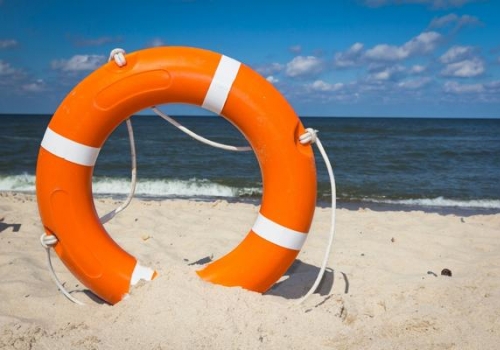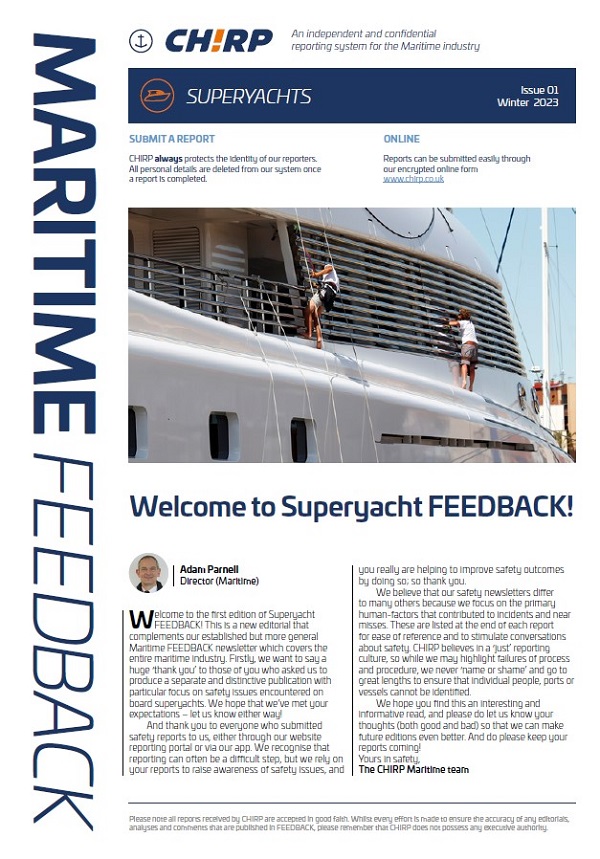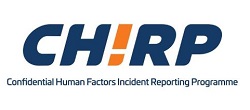CHIRP Maritime: Cultivating a Culture of Safety in the Superyacht Industry

"Learn from the mistakes from others - you don't live long enough to make them all yourself," Adam Parnell
This year marks the 20th anniversary of CHIRP's Maritime programme, which has worked continuously to tackle human factors regarding safety-related issues on board. “This maritime programme has been there for all vessels, from a paddle board to a Panamax," Adam Parnell, Director of CHIRP Maritime, tells OnboardOnline.
But, like many things in the maritime sector, superyachts can sometimes get left out on a limb, holding onto their niche alone. The UK-registered charity CHIRP is working to close one of these gaps in the safety world, having launched the first superyacht-specific programme and publication, Superyacht Feedback, this January.
CHIRP Superyacht Feedback
The simple aim of CHIRP is to improve safety, and the focus is on knowledge sharing to cultivate a better safety culture throughout the industry. “It is a peer-to-peer conversation, with yachties speaking to yachties," says Paul Naranjo-Shepherd, chair of CHIRP's Superyacht Maritime Advisory Board.
"We are there for better safety outcomes, and from people learning from mistakes. We are not there to augment people's existing report system, but for when people feel they cannot use the ordinary route," adds Parnell.
The simple system invites crew to send in reports, and a range of superyacht practitioners offers solutions for best practice. “We have a dedicated group of people reviewing the reports,” says Naranjo-Shepherd. “We wanted people on the panel that understood the sector and were still active within it.” As such, the panel comprises a group of around 12 yacht-experienced individuals currently within the deck and engineering departments. "We didn't want only to have very experienced captains towards the end of their careers,” he adds. “We wanted balance, so among the people we have experienced 3000GT captains, chief and second officers, chief engineers, captains under 3000 GT and people from shoreside management such as DPAs.”
 Completely confidential
Completely confidential
The confidentiality of the process weighs heavily on some crew members' minds for fear of losing employment or certification if their identities are discovered, but the aim of CHIRP is not to apportion blame. "We have never had a reporter identified in the 20 years of the maritime programme," Parnell (pictured left) explains encouragingly.
"We take huge steps to make sure people are always misidentified and quite often use Shutterstock imagery,” he adds. “We want to make sure no one can ever point the finger.” When it comes to the panel, each individual is asked to sign confidentiality agreements regardless. However once a report is received, the details of the crew members are already stripped, leaving just the reported situation. "When reviewing, we do not know the names of the crew involved, the yacht or the location where it happened," explains Naranjo-Shepard. These layers of confidentiality ensure that crew remain anonymous at all times.
What are the accidents and incidents?
In the past few years across superyacht media outlets, there has been a rise in the number of accidents and incidents on board superyachts. The jury is still out about the reasons behind this, but include a whole host of reasons from poor management and lack of experience to technical issues and system malfunction, as well as an increase in incident reporting.
So, what are the accidents and incidents in question? The first CHIRP Superyacht Feedback report covered a range of scenarios, from entrapment, grounding and injury to pressurised decisions and lack of equipment familiarity.
"The issue that gets mentioned to me the most when training crew is pressurised decisions," says Naranjo-Shephard. This reflects the importance of this sector-specific programme, especially in the superyacht industry over maritime, where crew are often put under pressure from owners to make risky decisions, with "no" being a particularly unpopular response.
The latest CHIRP newsletter, for example, covered a report on launching a jet ski in a prohibited area, with an "inebriated" and insistent owner. The captain felt under pressure from the ultimatum given to him by the owner to let him use it regardless, with the incident resulting in the death of a guest, traumatised crew and owner, and the captain losing his job. They are now under investigation with the threat of criminal prosecution.
 “A captain's first duty is the safety of crew and passengers, and they should have refused, no matter the circumstance," it states in the report. "To avoid such scenarios, captains are encouraged to confirm with the vessel owner that they are empowered to refuse requests that put people or the vessel at risk of harm." If this is not the case, it should be seen as a red flag. “Safety on board is likely to be compromised, and it is better to seek alternative employment," explains the report.
“A captain's first duty is the safety of crew and passengers, and they should have refused, no matter the circumstance," it states in the report. "To avoid such scenarios, captains are encouraged to confirm with the vessel owner that they are empowered to refuse requests that put people or the vessel at risk of harm." If this is not the case, it should be seen as a red flag. “Safety on board is likely to be compromised, and it is better to seek alternative employment," explains the report.
The aim of these reports is to learn from others, and if a crew member reads and relates to this, or any other scenario within the newsletter, they can be encouraged that they are not alone, and can learn from the comments and solutions provided.
An eager sector
Many crew seem to have resonated with the latest report. "Reception has been amazing,” says Naranjo-Shephard. “It is very heartening to see the level of engagement of the idea behind knowledge sharing." Parnell adds: "The strength of talking specifically to a sector and using evidence and incidents directly related to them holds a mirror up in a positive way so they can learn."
For best practice, CHIRP encourages all crew to print off the newsletter and display it in crew areas. It suggests discussing it in relevant crew meetings and using scenarios as examples within safety drills on board. "If crew read about an accident and then behave differently, and if we can save one life doing that, then the whole thing is completely worth it," says Naranjo-Shepherd.
Safely moving forward
Although the current reports have only been from the deck and engineering departments, CHIRP is hoping to extend into interior roles, encouraging any stews and chefs to come forward with reports, with an end goal to improve safety throughout all yachting departments.
“We have seen some yacht companies develop their own training materials based around the reports we have pushed out," says Parnell. What’s more, CHIRP is also in conversations with various yacht management companies to ensure that the newsletter goes out in all their fleet notices, making it part of all communications, and are also talking to flag states about distribution.
“The publication is for the industry, from the industry to the industry," says Parnell. The team therefore encourages all crew to keep sending in reports and welcomes any feedback to continue fostering this safety learning culture and knowledge sharing within the industry. They are keen to hear from anyone who wants to spread this message.
Improving safety throughout the industry is vital and needs everyone on board. Whether you send in a report, read and discuss or share the newsletter, you are paving the way for a safer industry.
Due to the popularity and feedback, CHIRP has already published the next edition and aims to publish quarterly.
Read the next edition of CHIRP's Superyacht Feedback here, and please sign up to the mailing list today.


Post your comment
You cannot post comments until you have logged in.
Login to post a commentComments
No one has commented on this page yet.
RSS feed for comments on this page | RSS feed for all comments